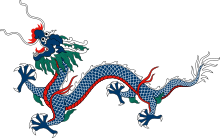
Back تنين صيني Arabic চীনা ড্ৰেগন Assamese Çin əjdahası Azerbaijani Dragon na Tsino BCL Китайски дракон Bulgarian Drac xinès Catalan Lṳ̀ng CDO Drage (kinesisk) Danish Long (Mythologie) German Κινεζικός δράκος (μυθολογία) Greek
 The Azure Dragon depicted on the flag of the Qing dynasty | |
| Grouping | Mythical creature |
|---|---|
| Sub grouping | Dragon |
| Folklore | Chinese mythology |
| Country | China |
The Chinese Dragon (Chinese: 龍; pinyin: lóng) is a legendary creature in Chinese mythology, Chinese folklore, and Chinese culture at large.[1] Chinese dragons have many animal-like forms such as turtles and fish, but are most commonly depicted as snake-like with four legs. Academicians have identified four reliable theories on the origin of the Chinese dragon: snakes, Chinese alligators, thunder worship and nature worship.[2] They traditionally symbolize potent and auspicious powers, particularly control over water.[3]
- ^ Lau, Chris (16 February 2024). "Happy New Year of the Dragon - or should that be 'Loong'?". CNN. Retrieved 19 February 2024.
- ^ Meccarelli 2021, pp. 123–142.
- ^ Carlson, Kathie; Flanagin, Michael N.; Martin, Kathleen; Martin, Mary E.; Mendelsohn, John; Rodgers, Priscilla Young; Ronnberg, Ami; Salman, Sherry; Wesley, Deborah A. (2010). Arm, Karen; Ueda, Kako; Thulin, Anne; Langerak, Allison; Kiley, Timothy Gus; Wolff, Mary (eds.). The Book of Symbols: Reflections on Archetypal Images. Köln: Taschen. p. 48. ISBN 978-3-8365-1448-4.
© MMXXIII Rich X Search. We shall prevail. All rights reserved. Rich X Search
